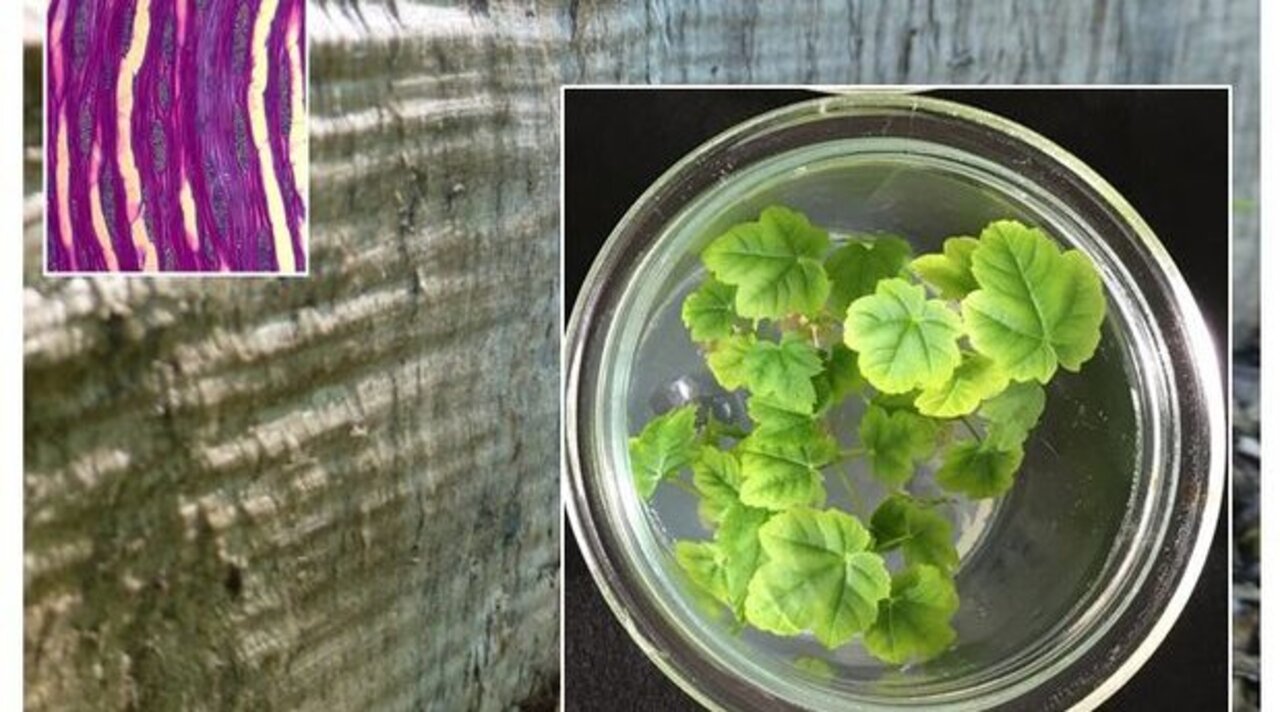Project
High value timbers

Strategies for the production of high value timbers
The aim of the joint project is to increase the value-added potential of European commercial tree species. To this end, methods are to be developed that contribute to the conservation, propagation and utilization of trees with special wood structures.
Background and Objective
Well known examples of woods with a value enhancing structural pattern are the particularly aesthetic fiddleback maple, the bird's eye maple and the figured or curly birch. A total of six project partners from the fields of genetics, plant cultivation and propagation (based on in vitro cultures), and wood research are cooperating in an interdisciplinary manner in the “Wertholz joint project”. In particular, the project aims to clarify the questions of how the special structures arise, whether and how they are inherited, and how the trees can be used in an economically efficient manner.
An existing “fiddleback” maple collection will be expanded into a “high value” wood collection by collecting corresponding wood genotypes which in turn come from donor trees whose logs have been sold to high prices at timber auctions. From these, crown scions or, ideally, root suckers or stump sprouts will be used to establish tissue cultures. The established clones represent a long-term preservable archive of genetic material that can be used to optimize the development of commercially applicable micropropagation protocols and generate significant numbers of clonal plants for use in forestry. The plant material produced will be marketed as high-value propagation material. Since the utilization of such wood is not expected for several decades, it is very difficult today to predict which timbers and grain patterns will be in particular demand in the future. Therefore, this project will not only concentrate on sycamore maple (Acer pseudoplatanus), which is very interesting economically today, but will also focus on wavy grain wood of other tree species and other special figured grain. For tree species subject to the Forest Reproductive Material Act (FoVG), clone testing will be carried out for later approval as tested reproductive material. To allow for early utilization, provisional approval is being sought. To support this, studies on heritability and causes of wavy grain are being conducted.
As in the previous project (“fiddleback” maple), project coordinator is Dr. Michael M. Wallbraun of RLP AgroScience GmbH (Germany, Neustadt a.d.W.).
Target Group
Science, Producers and Trade
Results
Important results have already been achieved in the previous project "Riegelahorn" (“fiddleback maple” project), on which the current project "Wertholz" builds.
There are already four experimental plots for clone testing of 17 propagatable sycamore clones which were established jointly by the Thünen Institute of Forest Genetics and the Northwest German Forest Research Institute (NW-FVA). They are maintained with the aim of identifying clones suitable for forestry and their approval according to the Forest Reproductive Material Act (FoVG). Valuable original material of further high-priced fiddleback maple strains was secured by grafting for long term experiments. The developed methods for in vitro establishment and micropropagation are also used as a standardized micropropagation protocol for commercial application by the project partners IFP and Hummel.
In two experimental plots for progeny testing of bolted and unbolted clones of a sycamore seed orchard of the NW-FVA, a parentage analysis with microsatellite markers was carried out by the Thünen Institute of Forest Genetics. With a random sample of initially 21 felled trees of these approximately 30-year-old progeny tests, the Thünen Institute for Wood Research investigated the wood formation, in particular the wavy grain trait. The proportion of samples with wavy grain was 43% in the progeny of wavy clones (mother and/or father generate wavy grain) and thus significantly higher than in progeny of non-wavy clones or unknown parents. The study of this small sample supports the hypothesis of heritability of the “wavy grain” trait.
Within the framework of the wood analyses carried out at the Thünen Institute for Wood Research, it was possible to develop a reliable method for characterizing the wavy grain for felled sycamore maple. The destructive method assesses the wavy grain based on the macroscopic analysis of log pieces of approx. 1 m length and classifies the wavy grain based on four categories (wavy grain: distinct, medium, weak, not wavy) and thus provides reliable information on the quality of the grain characteristics of the examined timbers.
Links and Downloads
Thünen-Contact

Involved Thünen-Partners
Involved external Thünen-Partners
-
RLP Agroscience GmbH
(Neustadt a.d.W., Deutschland) - Nordwestdeutsche Forstliche Versuchsanstalt (NW-FVA)
(Göttingen, Hann. Münden, Deutschland) -
Reinhold Hummel GmbH & Co. KG
(Stuttgart, Deutschland) -
Institut für Pflanzenkultur GmbH & Co. KG
(Schnega, Deutschland)
Funding Body
-
Fachagentur Nachwachsende Rohstoffe e.V. (FNR)
(national, öffentlich) -
Federal Ministry of Agriculture, Food and Regional Identity (BMLEH)
(national, öffentlich)
Duration
6.2021 - 12.2024
More Information
Project funding number: 2221NR009C
Project status:
finished

![[Translate to English:] [Translate to English:]](/media/_processed_/f/3/csm_2022_Titelbild_gross2_Saatgut_in_Hand_9ffb8f5748.jpg)
![[Translate to English:] [Translate to English:]](/media/_processed_/f/3/csm_2022_Titelbild_gross2_Saatgut_in_Hand_c17270fcc0.jpg)




